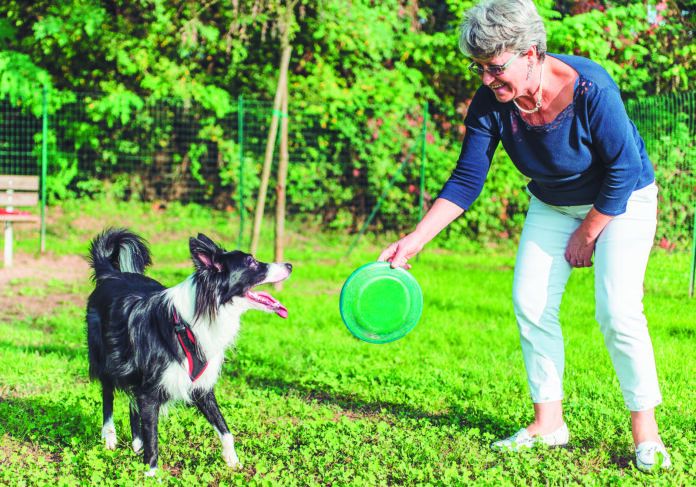Physical activity for a dog isn’t just about managing his weight, maintaining heart health, or slowing the muscle loss that comes with age and causes creeping frailty. Exercise is also very much about keeping up a dog’s mood and outlook on life. Just like for people, physical activity releases the feel-good brain chemical serotonin.
Even better, it strengthens your bond with your pet and makes him more well behaved. How so? When you engage your dog in physical activity, you’re right there with him, showing him that you like to do things with him. That makes him feel better about you and more willing to comply when you ask something of him.
But how much physical activity is right, depending on your dog’s age? Here’s a run-down.
Puppyhood
The right amount: Six to 10 short bursts of activity throughout the day.
It might seem that because puppies have frenetic energy, they need the most exercise of any canine age group. They don’t. Adult dogs need more. The reason is that while puppies run around like the energizer bunny, they also need more down time to recover from their turbocharged antics. Think about how a puppy can be playing and running one minute and then literally fall asleep at your feet the next. (That rest is what a puppy’s body needs to mature to adult size.)
With that in mind, you don’t want to take a puppy on, say, a long hike or engage him in a couple of hours of rigorous play. He’ll do better with short intervals of exercise throughout each day. By “short interval” we mean just five to 10 minutes at a time, six to 10 times a day (fewer as he passes six months of age).
It doesn’t all have to be outdoors. Simply playing with a puppy — throwing a ball from one room to the other for him to pounce on, chasing him around the house — counts.
Adulthood (but not yet geriatric)
The right amount: Between 60 and 90 minutes a day of vigorous activity.
Of course, an adult dog who is not a senior can be anywhere from two years old to eight or nine — or even 10 if he’s only 20 pounds or so. And generally speaking, a two-year-old is going to have a lot more energy than an eight-year-old. So it’s important to individualize your expectations for the time he spends working up a sweat, so to speak. But one thing that’s true for every adult dog, as long as he’s healthy: Two 20-minute walks each day is not going to be enough.
If your pet is from the sporting group (think: Labs, retrievers, spaniels, and setters), he’ll definitely need to reach the 90-minute upper end to be his best self. Running, playing with other dogs, or taking classes like agility and flyball can fill the bill. It’s the same for dogs from the herding group or who have a lot of herding dog in them. Even toy dogs need to go at it, although what’s vigorous for them can look different from what’s vigorous for a larger dog. They’re generally not going to run as far, for example.
Exercise is so important for adult dogs that if you don’t have an hour to an hour and a half every day to engage with yours, consider putting him in doggy daycare, where he can frolic with his kind. If you’re busy during the work week but have the time on the weekend, great! Just don’t make your dog a weekend warrior. As for a person, going at it hard just two days a week can strain his muscles, tendons, ligaments, and joints — unless you make sure he’s getting his exercise some other way during the week, when you are not available.
Old Age
The right amount: Thirty to 60 minutes a day, broken into two sessions.
Like middle age, “old” can vary widely. It can be 9 or 17, and it may or may not come with physical disabilities that can cause pain upon too much movement. Thus, 30 to 60 minutes daily should be thought of as a rule of thumb rather than a prescription.
Two longish walks is one way to meet your older dog’s exercise needs, but not the only one. Old dogs, like younger ones, appreciate variety and might still enjoy agility classes (especially if they’re “young” for their age) or hiking in new places — or swimming.





